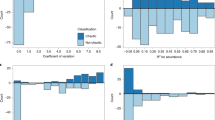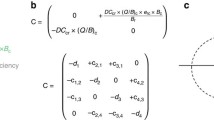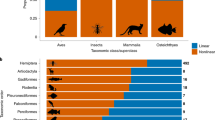Abstract
Real food chains are very rarely investigated since long data sequences are required. Typically, if we consider that an ecosystem evolves with a period corresponding to the time for maturation, possessing few dozen of cycles would require to count species over few centuries. One well known example of a long data set is the number of Canadian lynx furs caught by the Hudson Bay company between 1821 and 1935 as reported by Elton and Nicholson in 1942. In spite of the relative quality of the data set (10 undersampled cycles), two low-dimensional global models that settle to chaotic attractors were obtained. They are compared with an ad hoc 3D model which was proposed as a possible model for this data set. The two global models, which were estimated with no prior knowledge about the dynamics, can be considered as direct evidences of chaos in real ecosystems.
Similar content being viewed by others
References
Aguire L.A. and Letellier C. (2005). Observability of multivariate differential embeddings. J. Phys. A 38: 6311
Aguirre L.A. and Billings S.A. (1995). Identification of models for chaotic systems from noisy data: implications for performance and nonlinear filtering. Physica D 85: 239
Aguirre L.A., Freitas U.S., Letellier C. and Maquet J. (2001). Structure selection technique applied to continuous time nonlinear models. Physica D 158: 1
Blasius B. and Stone L. (2000). Chaos and phase synchronization in ecological systems. Int. J. Bifurcat. Chaos 10: 2361
Blasius B., Huppert A. and Stone L. (1999). Complex dynamics and phase synchronization in spatially extended ecological systems. Nature 399: 354
Cao L. (1997). Practical method for determining the minimum embedding dimension of a scalar time series. Physica D 110: 43
Cao L., Mees A. and Judd K. (1997). Modeling and predicting non-stationary time series. Int J Bifurcat. Chaos 7: 1823
Crutchfield J.P. and McNamara B.S. (1987). Equations of motion from a data series. Complex Syst. 1: 417
Elton C. and Nicholson M. (1942). The ten-year cycle in numbers of the lynx in Canada. J. Anim. Ecol. 11: 215
Gilmore R. and Lefranc M. (2002). The Topology of Chaos. Wiley, New York
Gilpin M. (1979). Spiral chaos in a predator prey model. Am. Nat. 113: 306
Gouesbet G. and Letellier C. (1994). Global vector field reconstruction by using a multivariate polynomial L 2-approximation on nets. Phys. Rev. E 49: 4955
Gouesbet G. and Maquet J. (1992). Construction of phenomenological models from numerical scalar time series. Physica D 58: 202
Gurney W.S.C., Blythe S.P. and Nisbet R.M. (1980). Nicholson’s blowflies revisited. Nature 287: 17
Hastings A., Hom C.L., Ellner S., Turchin P. and Godfray H.C.H. (1993). Chaos in ecology: is mother nature a strange attractor? Annu. Rev. Ecol. Syst. 24: 1–33
Kennel M.B., Brown R. and Abarbanel H.D.I. (1992). Determining embedding dimension for phase-space reconstruction using a geometrical construction. Phys. Rev. A 45: 3403
Letellier C. and Aguirre L.A. (2002). Investigating nonlinear dynamics from time series: the influence of symmetries and the choice of observables. Chaos 12: 549
Letellier C. and Aguirre L.A. (2005). A graphical interpretation of observability in terms of feedback circuits. Phys. Rev. E 72: 056202
Letellier C., Aguirre L.A. and Maquet J. (2005). Relation between observability and differential embeddings for nonlinear dynamics. Phys. Rev. E 71: 066213
Letellier, C., Aguirre, L.A., Maquet, J., Aziz-Alaoui.: Should all the species of a food chain be counted to investigate the global dynamics. Chaos Solitons Fractals 13, 1099 (2002)
Letellier, C., Bennoud, M., Martel, G.: Intermittency and period-doubling cascade on tori in a bimode laser model. Chaos Solitons Fractals (in press) (2007)
Letellier C., Dutertre P. and Maheu B. (1995). Unstable periodic orbits and templates of the Rössler system: toward a systematic topological characterization. Chaos 5: 271
Letellier C., Ménard O., Klinger Th., Piel A. and Bonhomme G. (2001). Dynamical analysis and map modelling of a thermionic diode plasma experiment. Physica D 156: 169
Letellier, C., Maquet, J., Aguirre, L.A., Gilmore, R.: An equivariant 3D model for the long-term behavior of the solar activity. In: Visarath (ed.) 7th Experimental Chaos Conference, San Diego, August 25–29, 2002 AIP Press, New York (2003)
Maquet J., Letellier C. and Aguirre L.A. (2004). Scalar modeling and analysis of a 3D biochemical reaction model. J. Theor. Biol. 228: 421
Nicholson J.A. (1957). The self-adjustement of populations to change. Cold Spring Harb. Symp. Quant. Biol. 22: 153
Packard N.H., Crutchfield J.P., Farmer J.D. and Shaw R.S. (1980). Geometry from a time series. Phy. Rev. Lett. 45: 712
Press W.H., Flannery B.P., Teukolsky S.A. and Vetterling W.T. (1988). Numerical Recipes. Cambridge University Press, Cambridge
Schaffer W.M. (1984). Stretching and folding in lynx fur returns: evidence for a strange attractor in nature? Am. Nat. 124: 798
Sinclair A.R.E., Gosline J.M., Holdsworth G., Krebs C.J., Boutin S., Smith J.N.M., Boonstra R. and Dale M. (1993). Can the solar cycle and climate synchronize the snowshoe hare cycle in Canada? Evidence from the tree rings and ice cores. Am. Nat. 141: 173
Sprott J.C. (1994). Some simple chaotic flows. Phys. Rev. E 50: 647
Upadhyay R.K., Jyengar S.R.K. and Rai V. (1998). Chaos: an ecological reality? Int. J. Bifurcat. Chaos 8: 1325
Author information
Authors and Affiliations
Corresponding author
Rights and permissions
About this article
Cite this article
Maquet, J., Letellier, C. & Aguirre, L.A. Global models from the Canadian lynx cycles as a direct evidence for chaos in real ecosystems. J. Math. Biol. 55, 21–39 (2007). https://doi.org/10.1007/s00285-007-0075-9
Received:
Revised:
Published:
Issue Date:
DOI: https://doi.org/10.1007/s00285-007-0075-9




